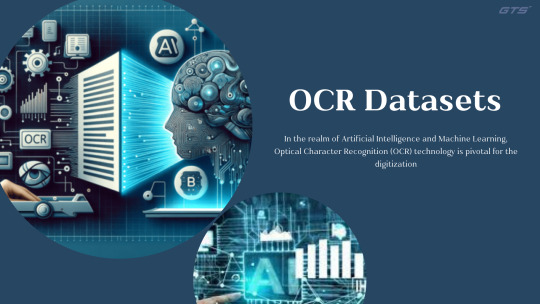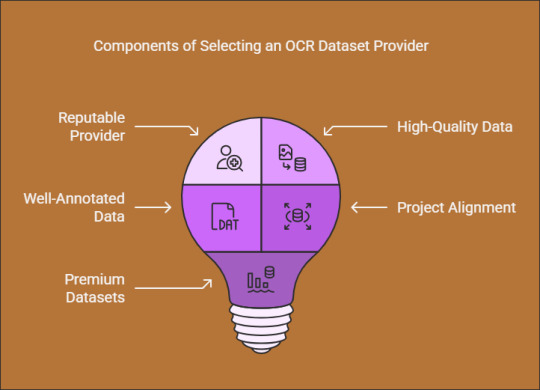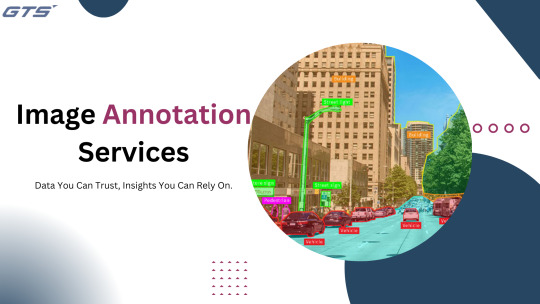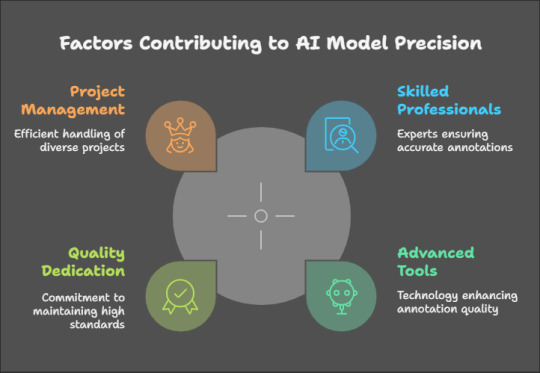#Image annotation
Explore tagged Tumblr posts
Text
Top Data Annotation Companies for Agritech in 2025

This labeled data helps AI algorithms make informed decisions, supporting farmers in monitoring fields and augmenting productivity.
Data annotation for agriculture data (sensor readings, images, etc) with relevant information allows AI systems to see and understand the crucial details of a farm environment. Do you want to explore where to outsource data labeling services personalized to your agriculture needs? You are reading the right blog, as we will list the top data annotation companies for agriculture in 2025. Let’s delve deeper!
0 notes
Text
Top 12 Image Annotation Use Cases: Unlocking AI Accuracy Through Outsourcing
This blog explores how image annotation powers AI applications across industries and why outsourcing it can significantly enhance accuracy, speed, and efficiency.

Popular Use Cases of Image Annotation Across Industries
Image annotation plays a critical role in training machine learning models to interpret visual data. The blog outlines 12 powerful applications:
Autonomous Driving – Identifying pedestrians, traffic signs, and lanes
Retail and Ecommerce – Enhancing visual search and personalized shopping
Healthcare – Assisting in diagnostics with annotated medical imaging
Security and Surveillance – Improving facial recognition and object tracking
Fashion – Powering virtual try-ons and style suggestions
Education – Creating interactive learning tools
Manufacturing – Supporting defect detection and process automation
Sports Analytics – Tracking players and in-game actions
Insurance – Analyzing claims through annotated visuals
Urban Planning – Mapping infrastructure and land use
Gaming – Creating immersive, AI-driven environments
Social Media – Filtering content and enhancing user experience
Advantages of Outsourcing Image Annotation Services
Outsourcing image annotation services helps organizations reduce costs and focus on strategic goals. Key benefits include:
Cost efficiency and quicker project delivery
Access to skilled annotators and advanced tools
High scalability and flexible management
Enhanced collaboration and consistent quality
Reduced operational risks
In-House vs. Outsourced Annotation
The blog guides readers in choosing between in-house and outsourced models based on project size, complexity, and budget.
Summing Up
From self-driving cars to social media platforms, image annotation is at the heart of AI innovation. This blog is a must-read for businesses aiming to boost AI accuracy through smart outsourcing strategies.
Read More: https://www.damcogroup.com/blogs/image-annotation-use-cases
0 notes
Text
Image Annotation Services: Powering AI with Precision
Image annotation services play a critical role in training computer vision models by adding metadata to images. This process involves labeling objects, boundaries, and other visual elements within images, enabling machines to recognize and interpret visual data accurately. From bounding boxes and semantic segmentation to landmark and polygon annotations, these services lay the groundwork for developing AI systems used in self-driving cars, facial recognition, retail automation, and more.
High-quality image annotation requires a blend of skilled human annotators and advanced tools to ensure accuracy, consistency, and scalability. Industries such as healthcare, agriculture, and e-commerce increasingly rely on annotated image datasets to power applications like disease detection, crop monitoring, and product categorization.
At Macgence, our image annotation services combine precision, scalability, and customization. We support a wide range of annotation types tailored to specific use cases, ensuring that your AI models are trained on high-quality, well-structured data. With a commitment to quality assurance and data security, we help businesses accelerate their AI initiatives with confidence.
Whether you're building object detection algorithms or fine-tuning machine learning models, image annotation is the foundation that drives performance and accuracy—making it a vital step in any AI development pipeline.
0 notes
Text
Data Annotation and Labeling Services
We specialize in data labeling and annotation to prepare raw data for AI systems. Our expert team ensures each dataset is carefully labeled, following strict accuracy standards. Whether you need image, text, audio, or video annotation, we provide high-quality training data for machine learning models. More Information: https://www.lapizdigital.com/data-annotation-services/
0 notes
Text
https://justpaste.it/cg903
0 notes
Text
How to Choose the Right OCR Dataset for Your Project

Introduction:
In the realm of Artificial Intelligence and Machine Learning, Optical Character Recognition (OCR) technology is pivotal for the digitization and extraction of textual data from images, scanned documents, and various visual formats. Choosing an appropriate OCR dataset is vital to guarantee precise, efficient, and dependable text recognition for your project. Below are guidelines for selecting the most suitable OCR dataset to meet your specific requirements.
Establish Your Project Specifications
Prior to selecting an OCR Dataset, it is imperative to clearly outline the scope and goals of your project. Consider the following aspects:
What types of documents or images will be processed?
Which languages and scripts must be recognized?
What degree of accuracy and precision is necessary?
Is there a requirement for support of handwritten, printed, or mixed text formats?
What particular industries or applications (such as finance, healthcare, or logistics) does your OCR system aim to serve?
A comprehensive understanding of these specifications will assist in refining your search for the optimal dataset.
Verify Dataset Diversity
A high-quality OCR dataset should encompass a variety of samples that represent real-world discrepancies. Seek datasets that feature:
A range of fonts, sizes, and styles
Diverse document layouts and formats
Various image qualities (including noisy, blurred, and scanned documents)
Combinations of handwritten and printed text
Multi-language and multilingual datasets
Data diversity is crucial for ensuring that your OCR model generalizes effectively and maintains accuracy across various applications.
Assess Labeling Accuracy and Quality
A well-annotated dataset is critical for training a successful OCR model. Confirm that the dataset you select includes:
Accurately labeled text with bounding boxes
High fidelity in transcription and annotation
Well-organized metadata for seamless integration into your machine-learning workflow
Inadequately labeled datasets can result in inaccuracies and inefficiencies in text recognition.
Assess the Size and Scalability of the Dataset
The dimensions of the dataset are pivotal in the training of models. Although larger datasets typically produce superior outcomes, they also demand greater computational resources. Consider the following:
Whether the dataset's size is compatible with your available computational resources
If it is feasible to generate additional labeled data if necessary
The potential for future expansion of the dataset to incorporate new data variations
Striking a balance between dataset size and quality is essential for achieving optimal performance while minimizing unnecessary resource consumption.
Analyze Dataset Licensing and Costs
OCR datasets are subject to various licensing agreements—some are open-source, while others necessitate commercial licenses. Take into account:
Whether the dataset is available at no cost or requires a financial investment
Licensing limitations that could impact the deployment of your project
The cost-effectiveness of acquiring a high-quality dataset compared to developing a custom-labeled dataset
Adhering to licensing agreements is vital to prevent legal issues in the future.
Conduct Tests with Sample Data
Prior to fully committing to an OCR dataset, it is prudent to evaluate it using a small sample of your project’s data. This evaluation assists in determining:
The dataset’s applicability to your specific requirements
The effectiveness of OCR models trained with the dataset
Any potential deficiencies that may necessitate further data augmentation or preprocessing
Conducting pilot tests aids in refining dataset selections before large-scale implementation.
Select a Trustworthy OCR Dataset Provider

Choosing a reputable dataset provider guarantees access to high-quality, well-annotated data that aligns with your project objectives. One such provider. which offers premium OCR datasets tailored for accurate data extraction and AI model training. Explore their OCR dataset solutions for more information.
Conclusion
Selecting an appropriate OCR dataset is essential for developing a precise and effective text recognition model. By assessing the requirements of your project, ensuring a diverse dataset, verifying the accuracy of labels, and considering licensing agreements, you can identify the most fitting dataset for Globose Technology Solutions AI application. Prioritizing high-quality datasets from trusted sources will significantly improve the reliability and performance of your OCR system.
0 notes
Text
Active Learning in Data Annotation: Reducing Effort and Maximizing Accuracy | CallCite

Active learning in data annotation streamlines AI training by focusing on the most impactful data. This method reduces annotation effort, saving time while enhancing accuracy. By prioritizing key data points, active learning boosts model performance without overwhelming resources. CallCite leverages this approach to deliver efficient, precise annotation solutions, helping you achieve reliable AI results with less effort. Experience smarter data annotation tailored to your needs with CallCite! For more information, please visit our official website or reach out at +1 (206) 337 9539.
0 notes
Text
Maximizing Efficiency in AI Projects with Image Annotation Services

Introduction:
Artificial Intelligence (AI) has revolutionized numerous sectors by streamlining processes, enhancing decision-making capabilities, and improving user interactions. A fundamental component that underpins the effectiveness of any robust AI model is data preparation, particularly through image annotation. As the demand for AI applications, especially in the realm of computer vision, continues to expand, the significance of image annotation services becomes increasingly critical in optimizing the performance and precision of AI initiatives.
This article will delve into the significance of image annotation services, the various forms of image annotations, and how these services can greatly enhance the results of AI projects.
Comprehending Image Annotation Services
Image Annotation Services refers to the process of labeling images or specific objects within those images to render them understandable to AI systems. This involves assigning meaningful tags to raw images, enabling AI technologies to interpret, identify, and categorize visual information. Annotation tasks can range from recognizing and classifying objects in images to delineating specific boundaries, points, or areas of interest.
These annotations serve as the essential "ground truth" for AI and machine learning algorithms, making them vital for developing models capable of executing intricate tasks such as object detection, facial recognition, and medical imaging analysis.
The Importance of Image Annotation Services for AI Projects
Although image annotation may appear straightforward, it demands a high level of accuracy, consistency, and specialized knowledge. Human annotators must grasp the subtleties of visual data and apply labels appropriately. Therefore, utilizing image annotation services is crucial for enhancing the efficiency of AI projects.
Precision in Model Training : AI models depend on precise data for effective predictions and classifications. Accurate image annotation is essential for ensuring that models learn from high-quality, well-labeled datasets, which enhances their performance. Inaccurate annotations can lead to misinterpretations by AI models, resulting in errors and inefficiencies within the system.
2. Enhanced Scalability : As AI initiatives expand, the demand for image annotation increases significantly. Delegating this responsibility to specialized image annotation services enables organizations to efficiently manage extensive datasets, thereby accelerating the training process without compromising quality. This scalability ensures that AI projects adhere to timelines and can accommodate growing data requirements.
3. Proficiency in Complex Annotation Tasks : Certain AI initiatives necessitate sophisticated annotation methods, such as pixel-level segmentation or 3D object detection. Professional image annotation services possess the expertise required to tackle these intricate tasks, guaranteeing that AI models receive the most precise and comprehensive annotations available.
4. Economic Viability : Establishing an in-house team of annotators for large-scale AI projects can incur substantial costs and require considerable time. Image annotation services offer a more economically viable alternative by providing access to a skilled workforce without the overhead expenses linked to hiring and training a complete team. This approach allows organizations to allocate resources to the primary aspects of their AI projects while outsourcing annotation tasks to experts.
5. Accelerated Time-to-Market : In the realm of AI projects, time is often a crucial element, particularly in competitive sectors. Image annotation services can dramatically reduce the time needed for image annotation, ensuring that AI models are trained swiftly and effectively. This expedited development cycle results in a quicker time-to-market for AI applications, providing businesses with a competitive advantage.
Types of Image Annotations
Various types of image annotations are employed in artificial intelligence projects, tailored to meet the specific requirements of each initiative. Among the most prevalent types are:
Bounding Boxes : Bounding boxes represent the most basic form of annotation, where annotators create rectangular outlines around objects within an image. This technique is frequently utilized in object detection tasks to instruct AI models on how to recognize and categorize objects present in images.
Polygonal Annotation : For objects with more complex shapes, polygonal annotation is utilized to delineate the exact contours of an object. This approach is particularly advantageous for irregularly shaped items or those with detailed boundaries, such as in satellite imagery analysis or medical imaging.
Semantic Segmentation : Semantic segmentation entails labeling each pixel in an image to categorize various regions. This annotation type is beneficial for applications that necessitate precise recognition, such as in autonomous driving or medical diagnostics.
Keypoint Annotation : Keypoint annotation consists of marking specific points within an image, such as facial landmarks in facial recognition tasks or joint locations in human pose estimation. This assists AI models in comprehending the relationships among different components of the image.
3D Cubes and LIDAR Annotation : In sophisticated AI applications, particularly in the realm of autonomous vehicles, 3D annotation techniques are employed. This involves labeling three-dimensional objects or utilizing LIDAR data to aid AI systems in understanding spatial relationships within a three-dimensional environment.
Advantages of Delegating Image Annotation to Experts
Although managing image annotation internally may appear viable, there are numerous advantages to entrusting this task to specialized services:
Uniformity and Standardization : Expert services employ established annotation protocols and tools to guarantee that each image is annotated uniformly. This uniformity is essential for training machine learning models, as discrepancies in annotations can adversely impact model performance.
Accelerated Turnaround : Delegating annotation tasks enables quicker completion of AI projects. Professional services are equipped to manage extensive datasets and can deliver high-quality annotations in a timely manner, thereby expediting the model training phase.
Access to Cutting-Edge Tools and Technology : Image annotation providers frequently utilize sophisticated software and tools that enhance both the efficiency and precision of the annotation process. These tools may feature capabilities such as auto-tagging, collaborative workflows, and quality assurance mechanisms to optimize the annotation workflow.
Quality Assurance and Error Identification : Reputable image annotation services implement rigorous quality control measures to identify and rectify errors. This minimizes the risk of incorrect labels impacting the training of the AI model, thereby contributing to the overall success of the AI initiative.
Conclusion
Image annotation services are vital for improving the efficiency and effectiveness of AI projects. By outsourcing the annotation process to professionals, organizations can ensure the precision, scalability, and rapidity of their AI systems. These services not only enhance the quality of training data but also assist companies in saving time, lowering costs, and maintaining a competitive advantage in the swiftly evolving landscape of AI technologies.
Investing in professional image annotation services represents a prudent decision for any organization aiming to fully harness the potential of AI.Whether you’re working on autonomous driving, facial recognition, or any other computer vision project, image annotation will be a key factor in maximizing your AI project’s efficiency and success.
Image annotation services play a pivotal role in maximizing the efficiency of AI projects by providing high-quality, labeled data that enhances the accuracy of machine learning models. Partnering with experts like Globose Technology Solutions ensures precise annotations tailored to specific project needs, driving faster development cycles and more effective AI solutions. The right image annotation strategy accelerates project timelines, optimizes resource allocation, and ultimately empowers businesses to achieve their AI goals with greater precision and efficiency.
0 notes
Text
Boost Your AI Model Accuracy with Expert Image Annotation Services

Introduction
In the ever-evolving realm of artificial intelligence (AI), the effectiveness of machine learning models is fundamentally linked to the quality of the data utilized for training. Image Annotation Company plays a vital role in the preparation of this data, especially in the context of computer vision applications. Whether the focus is on creating AI for self-driving cars, facial recognition systems, or medical imaging technologies, the precision and reliability of your model are contingent upon accurate annotations. Collaborating with a specialized image annotation firm can significantly enhance the outcome.
What Is Image Annotation?
Image annotation refers to the process of assigning metadata to images, which aids machine learning models in comprehending visual information. The types of labels applied can vary, including bounding boxes, polygons, key points, or semantic segmentation, based on the application's complexity. For example:
Bounding boxes are frequently utilized in object detection tasks.
Polygons are well-suited for recognizing objects with irregular shapes.
Key points are employed in facial recognition and pose estimation.
Semantic segmentation offers pixel-level annotations for precise object identification.
Each annotation type contributes distinctly to the training of AI models, enhancing their ability to execute tasks with accuracy.
The Importance of Expert Image Annotation
Professional image annotation services extend beyond mere labeling. They offer precise, consistent, and scalable solutions customized to meet your unique AI needs. The importance of collaborating with experts is highlighted by the following factors:
Precision Skilled annotators employ sophisticated tools and methodologies to guarantee accurate labeling, thereby reducing errors that may impact model efficacy.
Scalability AI initiatives frequently necessitate the annotation of thousands or even millions of images. Professional services possess the necessary resources and processes to expand annotation operations while maintaining high standards of quality.
Specialized Knowledge Certain applications, such as medical imaging or autonomous driving, demand specialized knowledge. Established annotation firms provide this expertise, ensuring that labels are both relevant and accurate.
Quality Assurance The implementation of quality control measures, including comprehensive reviews and automated verification systems, guarantees that the annotations adhere to the highest standards.
Applications of Image Annotation in AI
Healthcare: Marking X-rays, MRIs, and CT scans to support diagnostic artificial intelligence.
Autonomous Vehicles: Classifying pedestrians, vehicles, and traffic signs for autonomous driving systems.
Retail: Improving visual search capabilities and tailored recommendations via product identification.
Agriculture: Detecting crop health, pests, and weeds through labeled drone imagery.
Security: Educating AI for monitoring and facial recognition technologies.
Choosing the Right Image Annotation Partner
When choosing an image annotation company, it is essential to take into account the following considerations:
Expertise: Seek a company that has demonstrated success in your particular field.
Technological Capabilities: Utilizing sophisticated annotation platforms and AI-driven tools can enhance both efficiency and precision.
Capacity for Growth: Verify that the company is equipped to manage extensive projects as your requirements expand.
Data Protection: Select a partner that emphasizes confidentiality and secure management of data.
Why GTS Is Your Ideal Image Annotation Partner

At Globose Technology Solution , we focus on delivering exceptional image and video annotation services customized to meet your specific requirements. Our skilled professionals guarantee accurate annotations, allowing your AI models to attain unmatched precision. Utilizing advanced tools and a dedication to quality, we are prepared to manage projects of any size across various sectors.
Conclusion
Image annotation serves as a fundamental element in the training of AI models. Utilizing professional annotation services can significantly improve the precision, dependability, and effectiveness of your AI applications. Regardless of whether you are a nascent startup or a well-established corporation, prioritizing high-quality annotations is essential for achieving success in AI.
Are you prepared to elevate your AI models? Consider GTS’s image annotation services and learn how we can assist you in reaching your objectives.
0 notes
Text
High-Quality Image Annotation: The Foundation of AI Excellence

Introduction:
In the realm of artificial intelligence and machine learning, data holds paramount importance. Specifically, high-quality labeled image data is crucial for developing robust and dependable AI models. Whether it involves facilitating autonomous vehicles, enabling facial recognition, or enhancing medical imaging applications, accurate image annotation guarantees that AI systems function with precision and efficiency. At GTS.AI, we are dedicated to providing exceptional image annotation services customized to meet the specific requirements of your project.
The Significance of High-Quality Image Annotation
Image Annotation, or labeling, involves identifying and tagging components within an image to generate structured data. This annotated data serves as the cornerstone for training AI algorithms. But why is quality so critical?
Precision in Model Outcomes: Inaccurately labeled data results in unreliable AI models, leading to erroneous predictions and subpar performance.
Accelerated Training Processes: High-quality annotations facilitate quicker and more effective training, conserving both time and resources.
Enhanced Generalization: Well-annotated datasets enable models to generalize effectively, performing admirably even with unfamiliar data.
Primary Applications of Image Annotation
Image annotation has become essential across various sectors:
Autonomous Vehicles: Training vehicles to identify objects, traffic signs, and lane markings.
Healthcare: Assisting diagnostic tools with annotated medical images for disease identification.
Retail: Improving inventory management and personalized shopping experiences through object detection.
Security: Supporting facial and object recognition systems for surveillance and access control.
What Distinguishes GTS.AI?
At GTS.AI, we recognize that each project has distinct needs. Here’s how we guarantee superior image annotation services:
Cutting-Edge Annotation Techniques
We utilize a range of labeling methods, including:
Bounding Boxes: Optimal for object detection tasks.
Semantic Segmentation: Providing pixel-level accuracy
Scalability and Efficiency
Our international team, equipped with state-of-the-art tools, enables us to manage projects of any magnitude, providing timely results without sacrificing quality.
Comprehensive Quality Control
Each labeled dataset is subjected to several verification stages to ensure both accuracy and consistency.
Tailored Solutions
We customize our services to meet your unique requirements, whether related to annotation formats, workflow integration, or types of datasets.
Data Compliance and Security
The security of your data is our utmost concern. We comply with stringent data privacy regulations to ensure the confidentiality of your datasets.
Real-World Success Examples
Our image labeling services have enabled clients to achieve outstanding outcomes:
Healthcare Innovator: Supplied annotated X-ray images for training an AI model aimed at early disease detection.
Retail Leader: Labeled product images for a visual search application, enhancing customer engagement.
Autonomous Driving Pioneer: Provided high-quality annotations of road scenes, expediting AI training schedules.
Collaborate with GTS.AI for Exceptional Image Labeling
High-quality image labeling transcends mere service; it represents a strategic investment in the success of your AI projects. At Globose Technology Solutions, we merge expertise, technology, and precision to deliver unmatched results.
Are you prepared to advance your AI initiatives? Visit our image and video annotation services page to discover more and initiate your project today!
0 notes
Text
A leading predictive biotechnology research company developing AI-powered models for drug toxicity sought to evaluate whether its in silico systems could accurately detect Drug-Induced Liver Injury (DILI) using real-world clinical narratives, 2D molecular structure data, and high-content imaging. However, early model development was hindered by inconsistent image annotations, which introduced ambiguity in key cytotoxic phenotypes such as ER stress and cell death. These inconsistencies limited both the model’s accuracy and its interpretability.
0 notes
Text
Explore the power of image data collection and its role in transforming raw visuals into actionable intelligence. Learn how AI and machine learning are revolutionizing industries, from healthcare to autonomous vehicles, and shaping a smarter, data-driven future.
#artificial intelligence#machinelearning#aitraining#image data collection#AI Image Processing#Data to Intelligence#Image Recognition#Image Annotation
0 notes
Text



Vision API integration with Google Sheets & Forms, submit a test with this demo form. #ashtonfei #visionapi #googlesheets #googleforms #googleappsscript https://forms.gle/99TMz1PK9bvnA2j76
#ashtonfei#visionapi#googlesheets#googleforms#googleappsscript#google apps script#google sheets#youtube#onescript#upwork#freelance#google workspace#addon#text detection#image annotation#image labeling#color detection
0 notes
Text

0 notes